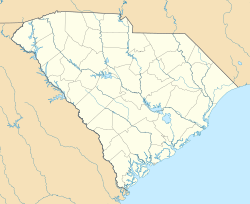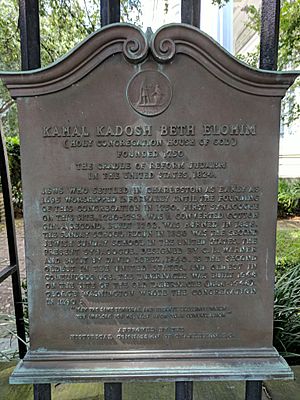Kahal Kadosh Beth Elohim facts for kids
Quick facts for kids Kahal Kadosh Beth Elohim |
|
|---|---|
|
Hebrew: קהל קדוש בית אלוהים
|
|

Kahal Kadosh Beth Elohim synagogue, 1938
|
|
| Religion | |
| Affiliation | Reform Judaism |
| Ecclesiastical or organizational status | Synagogue |
| Leadership |
|
| Status | Active |
| Location | |
| Location | 90 Hasell Street, Charleston, South Carolina |
| Country | United States |
| Architecture | |
| Architect(s) | Cyrus L. Warner |
| Architectural type | Synagogue |
| Architectural style | Greek Revival |
| General contractor | David Lopez Jr |
| Date established | 1749 (as a congregation) |
| Completed | |
| Specifications | |
| Direction of façade | South |
| Materials | Brick |
Kahal Kadosh Beth Elohim (which means "Holy Congregation House of God" in Hebrew) is a Reform Jewish congregation and synagogue. It is located in Charleston, South Carolina, in the United States.
This congregation was started in 1749. It is considered one of the oldest Jewish congregations in the United States. It is also known as the first place in the U.S. where ideas similar to Reform Judaism began.
Contents
History of the Congregation
Before 1830, Kahal Kodesh Beth Elohim (KKBE) was a place of worship for Spanish and Portuguese Jews. They followed Portuguese traditions. The congregation began as an Orthodox group. Later, it changed its religious practices to a more reformed style. This happened after a group that had split off, led by Isaac Harby, rejoined.
In 1824, the Reformed Society of the Israelites was formed by Portuguese Jews. This group adopted some ideas from the European Reform movement. They also created their own unique prayer book, which was the first of its kind in America. This group helped shape the later, larger American Reform movement.
The first members of KKBE were Sephardi Jews. They came from Spain and Portugal, arriving in Charleston from London, England. They worked in shipping and trade. While this congregation is sometimes seen as the start of Reform Judaism in the U.S., the main movement was later established by immigrants, mostly from Germany.
Important Leaders and Civil Rights
Rabbi Jacob S. Raisin served as the rabbi from 1915 to 1944. Another rabbi, Burton Padoll, led the synagogue in the 1960s. He was a strong supporter of civil rights for African Americans. However, some important members of the congregation did not agree with his support. Because of this, Rabbi Padoll had to leave his position.
The Synagogue Building
The current building is designed in the Greek Revival style. It is the second oldest synagogue building in the United States. It is also the oldest synagogue building in the U.S. that has been used continuously. The congregation also has the oldest Jewish cemetery in the United States that is still in use.
The building is made of brick and painted white to look like stone blocks. It has a grand entrance with six large columns. These columns support a triangular roof section. The architect, Cyrus L. Warner, designed the building. It was completed in 1840. The construction involved forced human labor from Black Africans. These individuals were owned by David Lopez Jr, a builder.
National Recognition
The building was added to the National Register of Historic Places on April 4, 1978. It was recognized as a National Historic Landmark on June 19, 1980. This means it is a very important historical site in the United States. The Coming Street Cemetery, which belongs to the congregation, is also listed separately on the National Register of Historic Places.
In 2021, a special monument was placed at the synagogue. It remembers the forced labor of Black Africans who helped build the site. Rabbi Stephanie Alexander said that by acknowledging this past, the congregation is being "honest and transparent."
Inside the synagogue, there is a mural. It shows a Jewish Confederate soldier with a broken sword. This artwork represents a historical idea known as the "Lost Cause of the Confederacy."
Notable People
Many interesting people have been members of this congregation:
- Joseph Levy, a soldier
- Moses Lindo, a trader
- David Lopez Jr, a builder and industrialist
- Francis Salvador, a plantation owner and the first Jewish person elected to public office in the U.S.
- Billy Simmons, an African-American Jew from the time before the Civil War
See Also
- List of National Historic Landmarks in South Carolina
- National Register of Historic Places listings in Charleston, South Carolina
- Oldest synagogues in the United States
- Touro Synagogue



